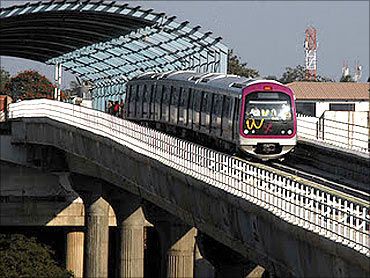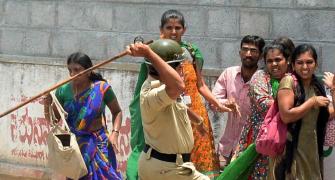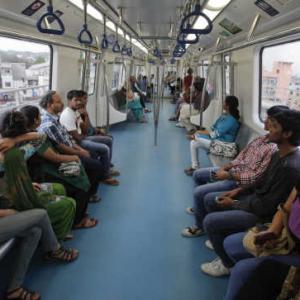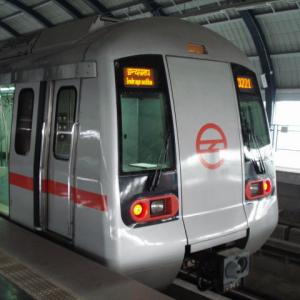
So far, Bangalore Metro Rail Corporation has been carrying around 20,000 passengers a day on two separate lines -- Byapanahalli to MG Road and Peenya to Malleswaram
A bus journey on the 18-km route from Byapanahalli to Nayandahalli in this city takes an average of two hours, snaking through the busiest localities.
The same journey on the metro rail, with 4.8 km underground, would cover the distance in 40 minutes.
The first phase of the Metro rail project will be inaugurated on Friday.
So far, Bangalore Metro Rail Corporation has been carrying around 20,000 passengers a day on two separate lines -- Byapanahalli to MG Road and Peenya to Malleswaram -- in the northern part.
The city will now see these two lines get connected, with BMRC officials expecting nearly half a million commuters to shift from private vehicles.
The primary connectivity is to Bengaluru's main bus stand, where an underground station has the capacity to handle 20,000 passengers at any time, from where the Metro splits to other locations.
“This will be a game changer.
"This stretch covers the heart of Bengaluru,” says Pradeep Singh Kharola, managing director of BMRC, who has a doctorate in public transport systems from Indian Institute of Technology, Delhi.
People will be able to cut commute times significantly.
Bengaluru, the country's fastest growing city, has also the highest density of vehicles per sq km.
With a population of at least 8.5 million, it has nearly 5.6 mn vehicles, with average speed of 10 kmph.
"We are at the beginning of the end of the first phase (of the Metro)," says Kharola.
"The Metro would be central to an efficient local transport system for the city. We are working with BMTC (the bus operator) and others to build a good system."
BMRC had envisaged building the first phase of the 42.3 km network, including the 4.8 km underground stretch, in five years with an initial budget of Rs 8,158 crore (Rs 81.58 billion).
The project has been delayed by four years, with an additional cost of nearly Rs 5,000 crore (Rs 50 billion).
The delays Kharola attributes to building the underground network, where machines had to bore tunnels — several were damaged due to the strong granite rocks of the Deccan Plateau.
"In normal courses, you can do around 30 metres of underground work in a day. In several places here, we would not have finished even a few centimetres because of the rocks," he says.
The network, named Namma Metro or Our Metro, still has around 400 metres of underground network that needs to covered by six months.
The second phase would connect the outskirts — the tech hub of Electronics City and Whitefield, helping de-stress the thousands of knowledge workers commuting on these routes.
This BMRC expects to be covered by 2020.
While the initial 4.8 km stretch has been tough, BMRC also has to build a 12-km underground network in another old part, on Tannery Road, to connect to the Ring Road, which potentially could connect to the international airport of the city in the third phase.
The latter phase might have to wait for another decade.
"In Phase-II, most of it would be elevated and we already have land acquisition in Whitefield and Electronics City.
"Our learnings in the initial underground stretch would help us plan better for the Tannery Road stretch," says Kharola, an IAS officer of the Karnataka batch, who speaks fluent Kannada.
Image: Bengaluru's swanky metro rail. Photograph: Rediff Archives










